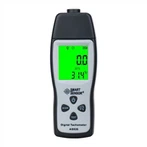Oscilloscopes are usually triggered in four ways:
(1) Normal (NORM): when there is no signal, there is no display on the screen; when there is a signal, the stable waveform is displayed in conjunction with the level control;
(2) Automatic (AUTO): when there is no signal, light traces are displayed on the screen; when there is a signal, stable waveforms are displayed in conjunction with the level control;
(3) TV field (TV): used to display the TV field signal;
(4) Peak AUTO (P-P AUTO): when there is no signal, the light trace is displayed on the screen; when there is a signal, a stable waveform display can be obtained without adjusting the level. This method is only used in some oscilloscopes (such as CALTEK CA8000 series oscilloscopes).
SweepMode
There are three scanning modes: Auto, Norm and Single.
Oscilloscope use - measurement methods
(1) Amplitude and frequency measurement methods (to test the calibration signal of the oscilloscope as an example)
(1) Insert the oscilloscope probe into the channel 1 jack and place the attenuation on the probe in 1st gear;
(2) Place the channel selection in CH1 and the coupling mode in DC gear;
(3) Insert the probe into the small hole of the calibration signal source, at this time the oscilloscope screen appears as a light trace;
(4) Adjust the vertical knob and horizontal knob to stabilise the waveform displayed on the screen, and place the vertical trim and horizontal trim in the calibration position;
(5) Read out the number of frames occupied by the waveform in the vertical direction and multiply it by the indicated value of the vertical attenuation knob to get the amplitude of the calibration signal;
(6) Read out the number of frames occupied by each cycle of the waveform in the horizontal direction, multiply it by the indicated value of the horizontal scanning knob to get the period of the calibration signal (the reciprocal of the period is the frequency);
(7) general calibration signal frequency of 1kHz, amplitude of 0.5V, used to calibrate the oscilloscope internal scanning oscillator frequency, if not normal, should be adjusted to the oscilloscope (internal) the corresponding potentiometer, until in line with so far.
The above brief introduction to the use of oscilloscopes, mainly the basic functions and operations. Oscilloscopes also have some more complex functions, such as delayed scanning, trigger delay, X-Y mode of operation, etc., will not be introduced here. Oscilloscope use in-depth introductory operation is also easy, really skilled in the application to master.






